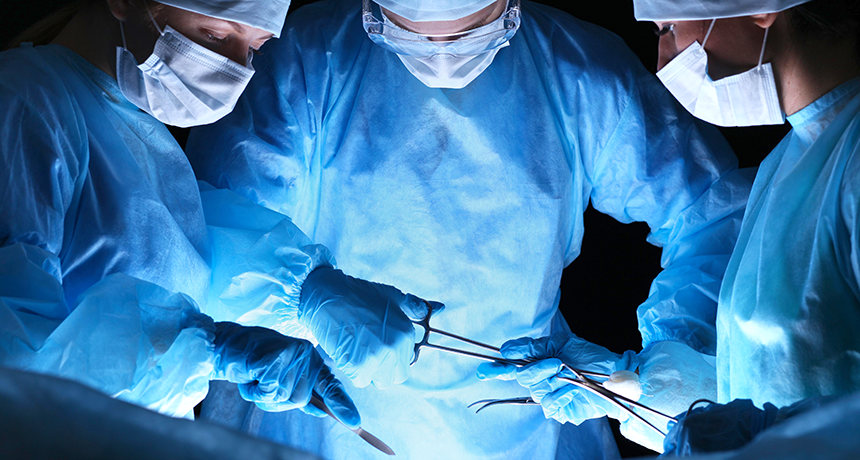A new electric surgery tool may someday fix nose, ear and eye problems
This painless alternative to traditional surgery uses electrochemistry to reshape tissue without causing scars

To reshape living tissue, surgeons usually cut into cells and stitch the wound. This type of surgery creates scars. A new, painless approach would damage few cells and might take only a few minutes.
andrei_r/iStock/Getty Images Plus
Our ears and noses contain a special tissue that’s softer than bone but stiffer than muscle. Reshaping this tissue for medical reasons usually requires “cut-and-sew” surgery. Healing from that type of surgery can be painful and leave scars. Soon, however, surgeons may avoid these problems by using electricity instead of a scalpel.
The special tissue is cartilage (KAR-tih-lidj). It’s difficult to reshape because its inner structure is very strong. It always bounces back into its original shape. The body has different types of cartilage. The form in our ears and nose is less rigid than the type in our joints, tendons and spinal discs.
Brian Wong is a surgeon who works at the University of California, Irvine. He’s also a biomedical engineer. He uses engineering know-how to solve medical problems. A few years ago, Wong was looking for ways to fix a deformed nose without cutting and stitching.
The cartilage that separates the nostrils inside the nose is known as the septum. In some people, this tissue is off-center or crooked. Such a “deviated” septum can make breathing difficult. Some people might be born with the problem. A sports injury or other trauma might also alter the septum’s shape.
Traditional septum surgery is challenging. The area that needs fixing is hard to reach. The space is tiny. Cutting into cells with blades tends to damage or kill the cells, creating scar tissue. The healing can prove painful. And mistakes can be quite visible.
To avoid some of these problems, Wong had tried heating the cartilage with an infrared (Inn-fruh-RED) laser as a new way to reshape the septum without a scalpel. That’s less invasive than cutting into the nose with a knife. And it worked. But the heating still damaged cells. This procedure also was expensive.
Electric current to the rescue
So Wong’s team decided to try heating the cartilage with an electric current. They started by working with a sample of cartilage in a lab dish. The current indeed let Wong reshape the tissue — but with hardly any temperature increase.
That was a big surprise.
To figure out what was going on, Wong contacted Michael Hill. He’s a chemist at Occidental College in Los Angeles, Calif. Hill studies how electricity affects chemical processes. And when he learned that 75 percent of cartilage consists of water, he had a hunch that the water might explain what happened. An electric current can split water into two atoms of hydrogen and one atom of oxygen. Chemists call this process electrolysis (Ee-lek-TRAHL-uh-sihs).
Hill’s hunch turned out to be right. And here’s how that electrolysis softened the tissue. That cartilage in our ears and noses is weblike. Its fibers are made from a protein called collagen (KAHL-uh-jen). Electric bonds between the molecules hold those fibers together. The negatively and positively charged parts of the molecules glom together like the positive and negative poles of two magnets.
So pulling apart the collagen web is like pulling apart two magnets. “If you let go, the molecules snap back together, like the magnets would,” explains Hill. “The electric bonds give cartilage the ability to hold its shape. But if we can briefly turn off the bonds, we can change that shape.”
The energy to turn off those bonds came from splitting the water in cartilage. Exposing a small region of the tissue to an electric current created hydrogen atoms that were positively charged. They canceled out the tissue’s negatively charged molecules. And that broke apart the electric bonds to make the cartilage malleable, like Play-Doh.
Now a surgeon could reshape the tissue. As soon as that doctor turned off the current, the electric bonds would quickly reform. The tissue’s new shape also would become permanent.
Bend an ear
Hill and Wong first tested the process on the ear of a rabbit that had died. Their goal was to permanently bend the ear 90 degrees from its normal, upright shape. To do this, they made a 3-D image of the ear. Using special computer software that the researchers had developed, they analyzed that image and printed a 3-D mold of the new shape they wanted to give that ear.
Their software then showed them the best place in the ear to place two tiny needles. Pulsing an electric current through these needles softened the tissue there. The software also figured out how long to send the current pulsing through those needles.
While delivering the current, the researchers bent the softened tissue into the new shape and then held it in place with the 3-D mold. Turning off the electricity allowed the cartilage to harden. It then kept that new shape after the researchers removed the mold. The entire process took only a few minutes.
“The chemistry couldn’t be simpler,” Hill says. “Not so simple,” he notes, “was figuring out how to zoom in on the small region we want to treat.”
The researchers first described this process three years ago in the journal Angewandte Chemie: International Edition. (The first part of the journal’s name is German and means applied chemistry.)
It took much longer to develop the computer software and test the reshaping of cartilage in live rabbits. The process killed very few cartilage cells, which proved a big advantage over traditional surgery. Hill reported his team’s new test data this past April at the American Chemical Society spring annual meeting in Orlando, Fla.
Those animal tests were really important, says Taylor Lawson, who was not involved with the research. He works at Boston University, where he studies knee and hip cartilage.
“You want to avoid injuries around the needle-insertion site,” he says. “You also need to know how much voltage to apply for a desired new shape. And you have to learn how to limit the electric current to just the area of interest.”
These are some of the things the researchers will now test in larger animals. Eventually, Hill and Wong hope to extend their team’s tests to humans. First, they have to ensure the new method will be safe to use in people. New medical procedures require many rounds of tests. Some are known as clinical trials.
If approved for humans, the new technique might be used to fix a deviated septum and other nose problems. It also could adjust ears that stick out. (This would help kids who get teased about “Dumbo” ears, says Hill.)
Eyes on the future
Hill and Wong wonder if their molecular surgery might have even broader uses, such as fixing vision problems. If it also works in people, Hill and Wong think their technique could help millions of people who are nearsighted, farsighted or have trouble reading as they get older.
Eyeballs aren’t made of cartilage. But like cartilage, the transparent layer on top of the eyeball — the cornea (KOR-nee-uh) — is made from a web of collagen fibers. In nearsighted people, the eyeball has grown too long, so the cornea is overly curved. That makes far-away objects appear blurry. Flattening the cornea fixes this problem. And electrolysis may be one way to do this.

So far, working in a lab dish, the researchers have only tried the technique on a rabbit’s cornea. They printed a mold for a contact lens and then painted electrodes onto it. After they put the mold onto the cornea, the researchers applied an electric current. This succeeded in changing the cornea’s shape.
The researchers have yet to try this on living animals. That means it will take many years to assess whether it is safe enough for people. But if it is, it one day might replace glasses and contact lenses in those who choose to have the procedure. The researchers think their method might pose fewer risks and side effects for correcting vision problems than laser surgery now does. That surgery “shaves off” thin layers of the cornea, instead of reshaping its tissue.
Hill and Wong are also working toward their original goal. Wong hopes he can soon fix ear and nose problems in a five-minute, low-cost procedure that can be done in a doctor’s office without causing pain or scars.
Chemist Stefanie Sydlik, who was not involved in the work, thinks that is a realistic goal. She studies cartilage and other body tissues at Carnegie Mellon University in Pittsburgh, Penn. This new technique should have great potential, she says, if the researchers can prove that it’s safe.
“The science behind it is really cool because it’s such a simple concept,” Sydlik says. “You use the water inside your own tissue to create the energy for changing its shape.”
This is one in a series presenting news on technology and innovation, made possible with generous support from the Lemelson Foundation.







